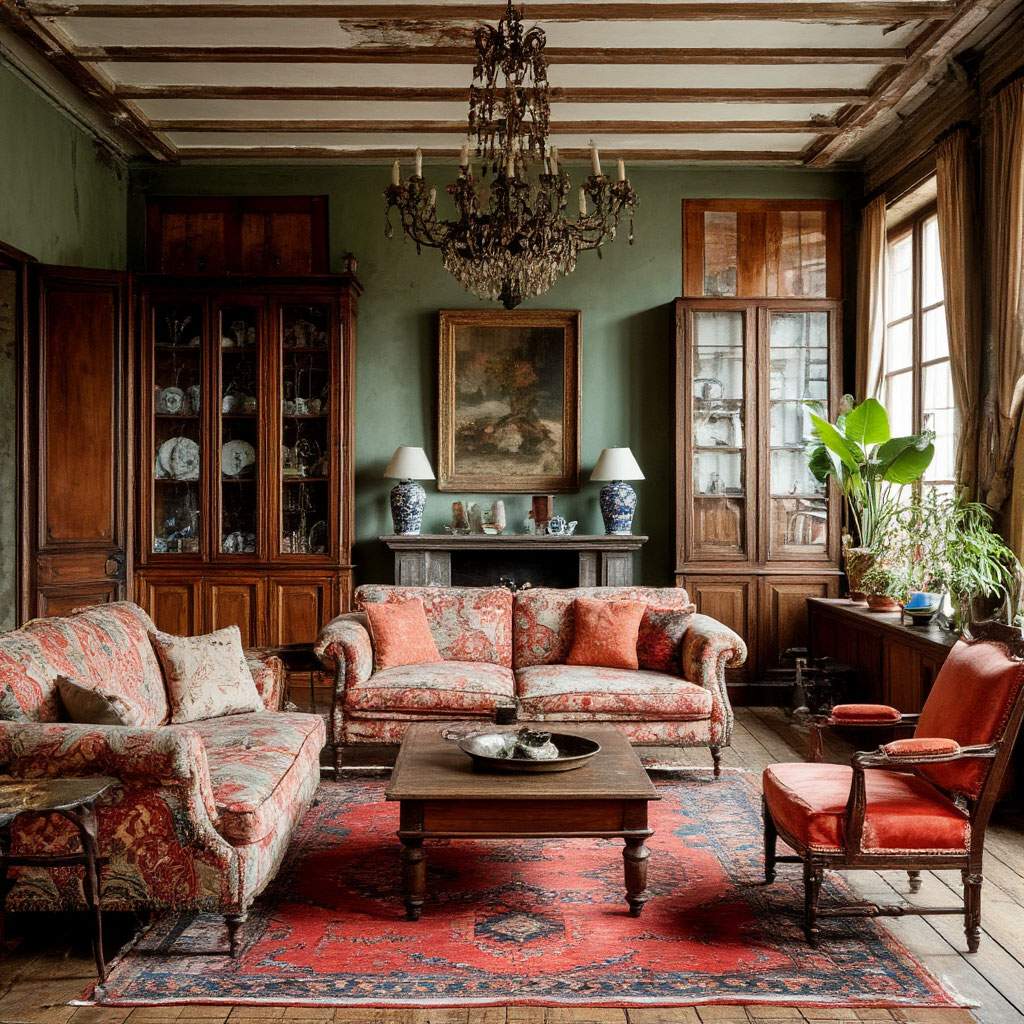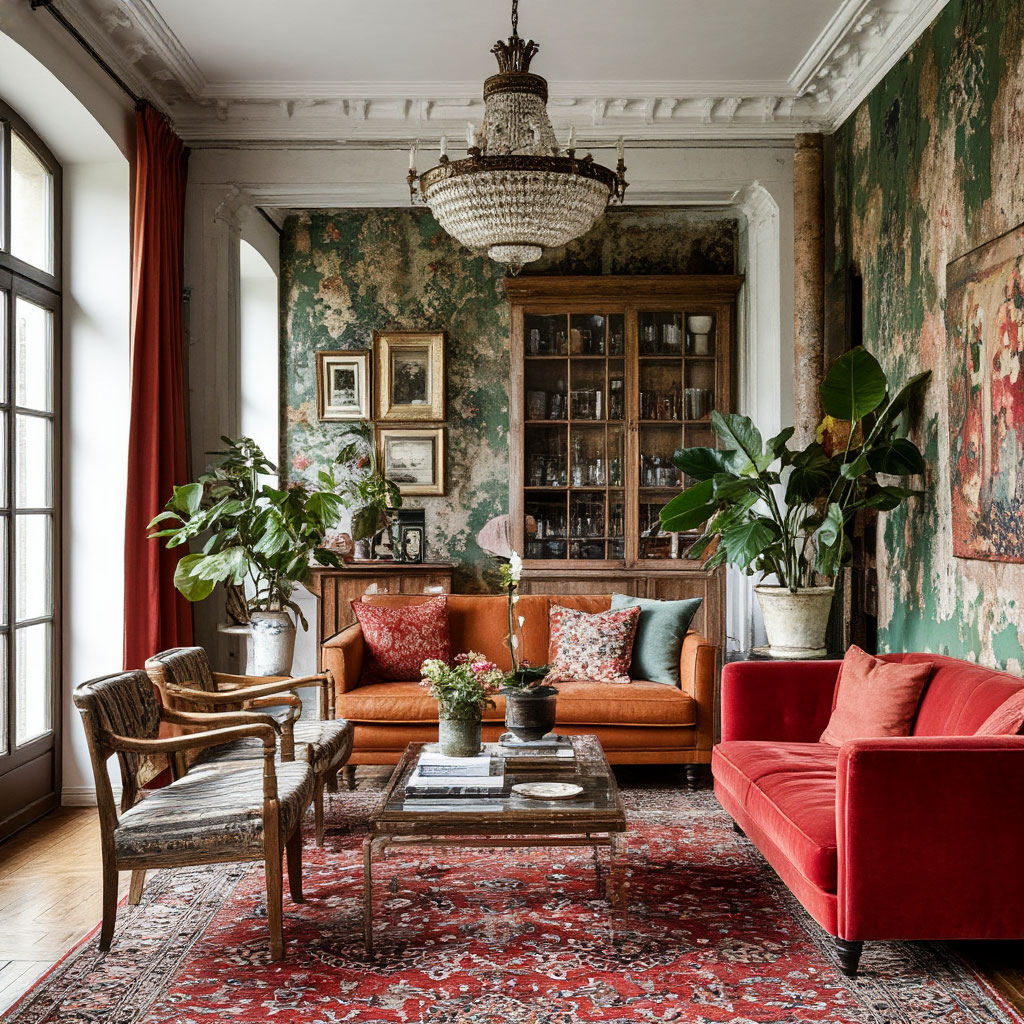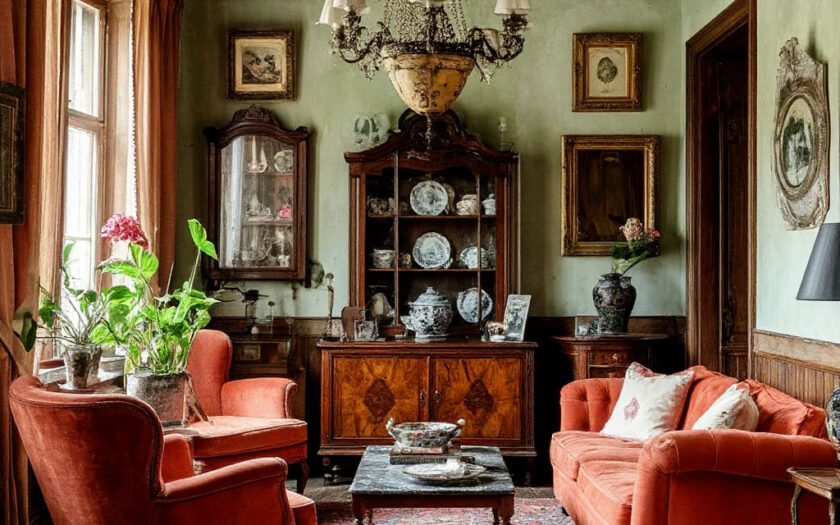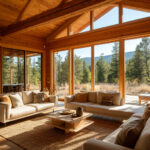So you wanna nail that Mixing Modern & Vintage for a Cool Look vibe? Good call. There’s something magic about blending sleek, clean-lined modern pieces with soulful, time-worn vintage decor—it’s the secret sauce behind those eclectic interiors that feel curated, not chaotic. But here’s the thing: pulling it off without looking like a thrift store exploded in your living room takes a little finesse. Whether you’re hunting for that perfect mid-century chair or trying to style a modern sofa with a vintage rug, we’ve got the lowdown on balancing old and new so your space feels fresh, personal, and totally Instagram-worthy. Let’s dive in.

Start with a Solid Base: Keep Your Big Pieces Neutral
The secret to successfully Mixing Modern & Vintage for a Cool Look begins with your foundational furniture choices. These anchor pieces – your sofa, bed, and dining table – should create harmony between eras rather than competition. When done right, this approach allows your vintage decor to shine while maintaining a fresh, contemporary feel through strategic modern elements.
Why Neutral Foundations Matter
Neutral doesn’t equate to bland when Mixing Modern & Vintage for a Cool Look. A muted palette actually enhances the visual dialogue between pieces from different eras. Consider how a modern sofa in soft gray allows a vintage Persian rug to become the room’s focal point, or how a simple oak dining table lets vintage chairs command attention. The key is selecting foundational pieces with clean lines and timeless appeal that won’t overshadow your statement items.
Mastering Texture and Proportion
Texture becomes your most powerful tool when Mixing Modern & Vintage for a Cool Look. Pair smooth modern surfaces with the patina of vintage materials – imagine polished concrete floors against a weathered leather armchair, or a sleek metal coffee table beside a nubby wool throw. These contrasts create depth while maintaining balance in your eclectic interiors.
Proportion plays an equally important role. A low-profile modern sectional can be beautifully offset by a tall vintage bookcase, while a streamlined platform bed gains character from substantial vintage nightstands. This interplay of scales prevents any single era from dominating the space.
Strategic Color Application
While neutral foundations are essential when Mixing Modern & Vintage for a Cool Look, color should be introduced thoughtfully. Use your modern pieces as a neutral canvas, then layer in color through vintage accessories. A monochromatic modern sofa becomes the perfect backdrop for vibrant vintage pillows, just as a simple dining table lets colorful vintage china take center stage.
For rooms where you’ve incorporated a colorful anchor piece, like a vintage emerald green sofa, balance it with modern elements in complementary neutrals. The contrast between the bold vintage piece and restrained modern companions creates visual tension that feels intentional rather than accidental.
Creating Cohesion Through Details
The finishing touches make all the difference when Mixing Modern & Vintage for a Cool Look. Repeat materials throughout the space to create continuity – if you have a vintage brass lamp, echo that finish in modern cabinet hardware. Use artwork to bridge the gap between eras, perhaps pairing a contemporary abstract piece with an ornate vintage frame.
Lighting offers another opportunity to blend styles. A modern pendant light over a vintage dining table creates an exciting contrast, while vintage sconces can add character to an otherwise modern bathroom. These thoughtful combinations are what elevate eclectic interiors from haphazard to harmonious.
The Evolution of Your Space
Remember that Mixing Modern & Vintage for a Cool Look is an ongoing process. Start with your neutral foundations, then gradually introduce character pieces as you find them. The best spaces tell a story over time, with each addition contributing to the narrative. Whether you’re incorporating a single vintage find among modern furnishings or creating a more balanced mix, let your space evolve organically while maintaining those crucial neutral anchors that keep everything cohesive.

Throw in Some “Wow” Vintage Finds
The fun part is hunting for unique retro pieces that will make your space stand out. Mixing Modern & Vintage for a Cool Look isn’t just about slapping an old chair next to a new sofa; it’s about curating items with personality that spark conversation. Think of your antique treasures as the seasoning—too little and your room falls flat, too much and it overwhelms. Here’s how to nail the balance.
The Hunt: Where to Score Killer Retro Pieces
First rule of Mixing Modern & Vintage for a Cool Look? You gotta dig for the good stuff. Flea markets, estate sales, and even Facebook Marketplace are goldmines for secondhand treasures with history. Look for items that have stood the test of time—a mid-century dresser with dovetail joints, a ’70s rattan chair with intact weaving, or an industrial lamp with its original patina. The goal? Find pieces that feel special, not just old.
Pro tip: If you’re shopping online, zoom in on photos for wear and tear. Authentic retro decor shows its age—chips in ceramic, fading on fabrics, or slight rust on metal. That’s what gives it soul.
The Statement Piece: Let One Retro Hero Shine
In a room full of contemporary basics, one showstopping antique find can do all the heavy lifting. Maybe it’s a Hollywood Regency mirror with crazy detailing, a Danish teak credenza, or a funky ’80s floor lamp. Whatever it is, give it space to breathe. Position it where the eye lands naturally—accent chairs facing a fireplace, a bold rug under a coffee table, or a sculptural light fixture over a dining table.
The trick? Keep the surrounding items simple. A sleek neutral sofa lets a retro velvet armchair pop. Minimalist shelves make a collection of antique ceramics look intentional, not cluttered.
Small but Mighty: Retro Accessories That Pack a Punch
Not ready to commit to big antique furniture? Start small. Mixing Modern & Vintage for a Cool Look works just as well with decorative items. Scour thrift stores for:
- Old hardcover books with cool spines.
- Brass candlesticks or tarnished silver trays.
- Retro posters or framed botanical prints.
- Woven baskets or clay pottery.
These little touches add layers to your eclectic interiors without screaming “grandma’s attic.” Cluster them in groups for impact—stacked books under a contemporary lamp, a trio of antique vases on a windowsill, or a gallery wall mixing old and new art.
When Retro Gets Quirky: Embracing the Unexpected
The best secondhand finds often come with a backstory. Maybe it’s a dentist’s cabinet repurposed as a bar, an old school map as wall art, or a factory cart turned coffee table. These conversation starters give your space personality you can’t buy new.
The key to Mixing Modern & Vintage for a Cool Look here? Contrast. Pair something unexpectedly old with something undeniably contemporary—like an antique apothecary jar on a glossy acrylic shelf, or a rustic wooden stool under a sleek hairpin-leg desk. The juicier the contrast, the better it works.
Avoiding the “Thrift Store” Vibe
Here’s the thing—retro done wrong can look like a yard sale. To keep your eclectic interiors feeling curated:
- Stick to a loose color scheme (e.g., warm woods + black metal + cream textiles).
- Limit patterns—if your antique rug is busy, keep upholstery solid.
- Mix eras intentionally (don’t crowd ’50s, ’70s, and ’90s pieces together).
Remember: Mixing Modern & Vintage for a Cool Look is about editing. If a piece doesn’t make your heart race or solve a design problem, leave it behind.
The Refresh Factor: Upcycling Retro Finds
Some antique items need a little love. A fresh coat of paint on a chipped dresser, reupholstering a chair in contemporary fabric, or polishing tarnished hardware can bridge the gap between old and new. Just don’t overdo it—preserve what makes the piece unique, like carved details or original finishes.

Balance is Key: Don’t Let One Era Take Over
The art of Mixing Modern & Vintage for a Cool Look lies in achieving harmony between different periods. A space filled only with mid-century pieces becomes a time capsule, while an entirely contemporary room risks feeling sterile. The magic happens when these elements coexist seamlessly, creating that perfectly balanced blend of old and new that defines successful Mixing Modern & Vintage for a Cool Look.
The 70/30 Rule for Harmonious Blending
A practical approach to Mixing Modern & Vintage for a Cool Look involves letting one era anchor about 70% of the space while the other makes up the remaining 30%. This formula maintains cohesion while allowing for character. For example:
- A living room with predominantly clean-lined furniture gains personality through strategic vintage accents
- A bedroom with contemporary foundations feels warmer with traditional nightstands
- A sleek kitchen benefits from retro-inspired seating
This distribution creates the ideal balance for Mixing Modern & Vintage for a Cool Look, preventing either style from overwhelming the space.
Avoiding Themed Spaces
When Mixing Modern & Vintage for a Cool Look, rooms that lean too heavily into one era risk feeling staged. The solution lies in thoughtful contrast. Pair straight-lined contemporary furnishings with curved traditional pieces to create visual interest. The key to successful Mixing Modern & Vintage for a Cool Look is ensuring neither period dominates completely.
Material Harmony
Thoughtful material combinations are essential when Mixing Modern & Vintage for a Cool Look:
- Combine sleek metals with time-worn woods.
- Pair glass surfaces with textured traditional fabrics.
- Balance polished concrete with patterned rugs.
These pairings allow each piece to shine while creating cohesion between eras in your Mixing Modern & Vintage for a Cool Look design scheme.
Color as a Unifying Thread
A consistent color palette is crucial for Mixing Modern & Vintage for a Cool Look. Select core hues that work across periods:
- Neutrals that flatter both metal finishes and wood tones.
- Deep blues that complement contemporary and classic pieces.
- Earthy greens that connect different aesthetics.
Knowing When to Bend the Rules
The principles of Mixing Modern & Vintage for a Cool Look include recognizing when to deviate. Sometimes architectural features demand stronger contemporary presence, while other spaces benefit from more vintage character. The flexibility of Mixing Modern & Vintage for a Cool Look allows for these adaptations while maintaining overall balance.
Trusting Your Instincts
The true test of successful Mixing Modern & Vintage for a Cool Look comes when entering the room. Does it feel purposeful yet effortless? When conversation pieces spark interest without dominating, you’ve achieved that perfect equilibrium of Mixing Modern & Vintage for a Cool Look.

Play with Textures & Finishes: The Secret Sauce for Depth
You know that instantly inviting room that just feels right? Nine times out of ten, it’s rocking killer texture combinations. When you’re Mixing Modern & Vintage for a Cool Look, playing with materials is what transforms a space from flat to fascinating. It’s the difference between a showroom and a home with soul. Here’s how to master the mix.
Texture: The Magic Ingredient in Your Design Cocktail
The secret to nailing Mixing Modern & Vintage for a Cool Look lies in contrast. That slick contemporary leather sofa comes alive when draped with a chunky knit throw from the 70s. A polished concrete floor suddenly feels cozy under a well-loved Persian rug. These combinations are what make eclectic interiors feel curated rather than chaotic.
The golden rule? Pair opposites. Hard surfaces with soft textiles. Glossy finishes with matte textures. Try a sleek glass coffee table on a nubby wool rug, or place a shiny brass lamp beside a rough wooden side table. These unexpected pairings create the visual tension that makes Mixing Modern & Vintage for a Cool Look so compelling.
Finishes That Tell a Story
Nothing bridges eras like thoughtful finish combinations. Metals are your easiest win for Mixing Modern & Vintage for a Cool Look:
- Brass with its warm patina brings instant vintage character.
- Brushed nickel keeps things clean and contemporary.
- Mixed metals add that collected-over-time vibe.
Wood tones work the same magic. A modern ash dining table becomes infinitely more interesting when paired with vintage mahogany chairs. Just remember to repeat each finish at least twice in a room to maintain intentionality.
Fabric Alchemy: Weaving Eras Together
Textiles are where Mixing Modern & Vintage for a Cool Look really shines. Take a contemporary linen sofa and:
- Layer on vintage velvet pillows for luxury.
- Drape a rough woven throw for contrast.
- Add a buttery leather pouf for depth.
Window treatments offer another texture playground. Pair sheer modern curtains with heavy vintage tiebacks, or match sleek roller shades with rustic wooden blinds. These combinations create the layered look that defines successful eclectic interiors.
Walls: Your Texture Canvas
Don’t neglect vertical surfaces when Mixing Modern & Vintage for a Cool Look. Consider:
A smooth modern gallery wall in ornate vintage frames
Exposed brick (the ultimate texture) with glossy contemporary art
Grasscloth wallpaper behind floating shelves
Even small details matter. Swap basic outlet covers for vintage-style brass or porcelain plates. These tiny touches add up to big impact in your eclectic interiors.
The Texture Trifecta Rule
Here’s a pro tip for Mixing Modern & Vintage for a Cool Look: always combine at least three textures in any area. A bedside setup might include:
- A polished modern lamp base.
- A vintage wood nightstand.
- A nubby woven storage basket.
This creates natural visual interest without overwhelming the space.
Knowing When to Press Pause
While texture is key to Mixing Modern & Vintage for a Cool Look, restraint matters. One statement textured wall? Stunning. Every surface competing for attention? Exhausting. If your eclectic interiors start feeling chaotic, simplify to one standout texture per zone.
Keep It Personal: Because Trends Come & Go
Here’s the truth nobody tells you about Mixing Modern & Vintage for a Cool Look – the best spaces don’t follow rules, they follow heartbeats. That weird lamp your grandma gave you? The one that “doesn’t go with anything”? That’s your secret weapon. This chapter is about throwing out the rulebook and designing a space that’s unmistakably you.
The “Screw the Trends” Approach to Eclectic Style
We’ve all seen those picture-perfect eclectic interiors that look like they were designed by algorithm. Here’s the thing – real Mixing Modern & Vintage for a Cool Look has fingerprints all over it. Maybe it’s:
- That beat-up trunk you dragged through three apartments
- The weird abstract painting your kid made in second grade
- Your great-aunt’s china you actually use for pizza nights
These are the pieces that transform a stylish space into your space. That vintage decor item everyone told you to ditch? If it makes you smile every time you see it, it stays.
How to Spot Your True Keepers
When Mixing Modern & Vintage for a Cool Look, here’s how to separate meaningful pieces from clutter:
- The Story Test: Does it have a memory attached? Keep it
- The Joy Check: Does your mood lift when you see it? Display it
- The Practicality Rule: Do you actually use/enjoy it? Find it a home
Your modern sofa might be the backdrop, but that vintage decor piece from your travels? That’s the conversation starter.
Making Oddballs Work Together
The magic of Mixing Modern & Vintage for a Cool Look shines when you unite misfits. Try:
- Grouping three seemingly unrelated vintage decor items by color
- Using similar frames to unify different art styles
- Letting one material (like wood or brass) connect modern and vintage pieces
That vintage typewriter on your modern desk? It’s not “out of place” – it’s intentional eclecticism.
The Evolution of Your Space
Unlike matchy-matchy decor, Mixing Modern & Vintage for a Cool Look is never “done.” It grows as you do. Maybe you’ll:
- Swap out modern accessories as your vintage collection grows
- Rotate artwork seasonally to keep things fresh
- Gradually replace mass-produced items with unique finds
This approach means your space tells your story – not some designer’s.
When to Actually Listen to Advice
Even personal spaces need some guardrails. If your eclectic interiors start feeling:
- Like a thrift store explosion → edit down
- Overwhelmingly cluttered → create breathing room
- Too safe and generic → add more personality
The sweet spot? When guests say “This is so you” rather than “This is so stylish.”
Bottom Line: Your Space, Your Rules
Mixing modern & vintage for a cool look isn’t about testing design boxes, it’s about creating a home that’s truly yours. The best spaces aren’t built overnight; they evolve, just like you do. Maybe you’ll stumble upon the perfect vintage find at a flea market next weekend, or maybe you’ll give that unusual family heirloom the attention it deserves.
The important thing is that your space tells your story. Not the story of a Pinterest board. Not the story of some interior designer. Your story. The scratches on that mid-century chair? They prove it was loved. The modern art print that “doesn’t fit” with your traditional architecture? That’s called character.
Forget the rules. Forget the trends. If you like it, it works. That’s the real secret to mixing modern and vintage for a cool look—confidence trumps perfection every time. Now make some design decisions that will make the minimalist heart beat faster. Your future eclectic, completely unique space will thank you.





